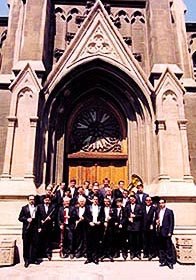|

Winter
1998 (6.4)
Architecture
of the Oil Baron Period
German
Lutheran Church
28th of
May Street 17
The German Lutheran Church was
converted into a music recital hall during the Soviet period,
a role which it still serves today.
During the Oil
Boom at the turn of the last century, many Europeans flocked
to Baku. It wasn't long before the expatriate German community
built themselves a church which today is still commonly referred
to by the German word for church, "kirche."
The architect was a German named Eikhler who based his design
on the Gothic style. Construction was carried out between 1895
and 1898. Two houses were also built at the same time on either
side of the church-one served as the residence for the Lutheran
clergy; the other housed four German benevolent societies.
In 1910 a Walker pipe organ was installed and evening organ performances
in the church became a tradition. Fortunately, the church was
one of the few religious buildings that was not demolished during
the Soviet period when Stalin went on a rampage to stamp out
religion. Instead, it was changed into a music hall. In 1939,
the church's
pipe organ
was
dismantled and taken to the Music Conservatory. In the process,
however, the organ was so badly damaged that it became impossible
to restore. In 1990 a new Rieger Klaus pipe organ with 43 registers
was installed. Today, the building is still known for its fine
acoustics and continues to be used as a recital hall, primarily
for chamber orchestra concerts and organ recitals.
From Azerbaijan
International
(6.4) Winter 1998.
© Azerbaijan International 1998. All rights reserved.
Back to Index
AI 6.4 (Winter 1998)
AI Home
| Magazine
Choice | Topics
| Store
| Contact
us
|


